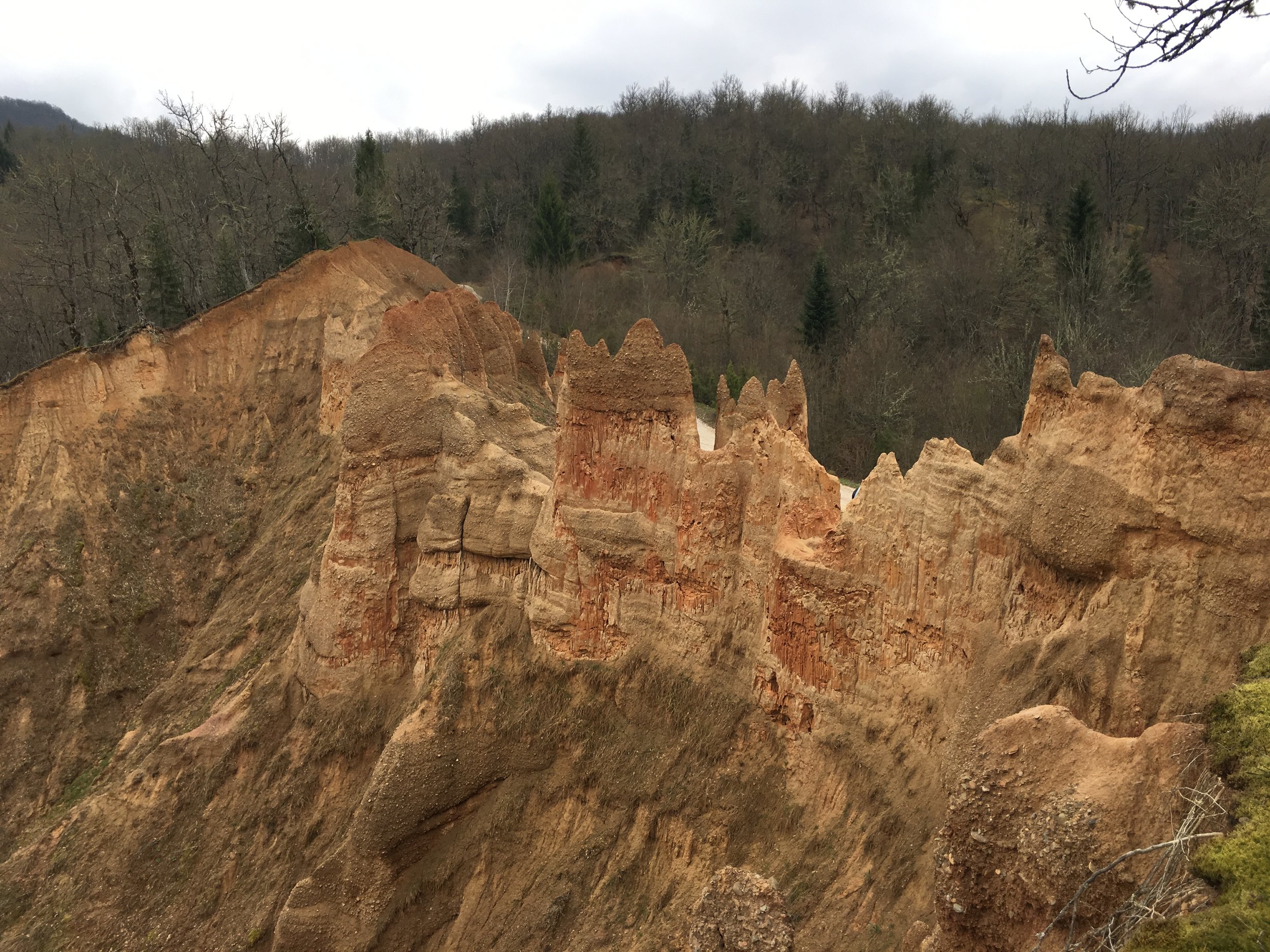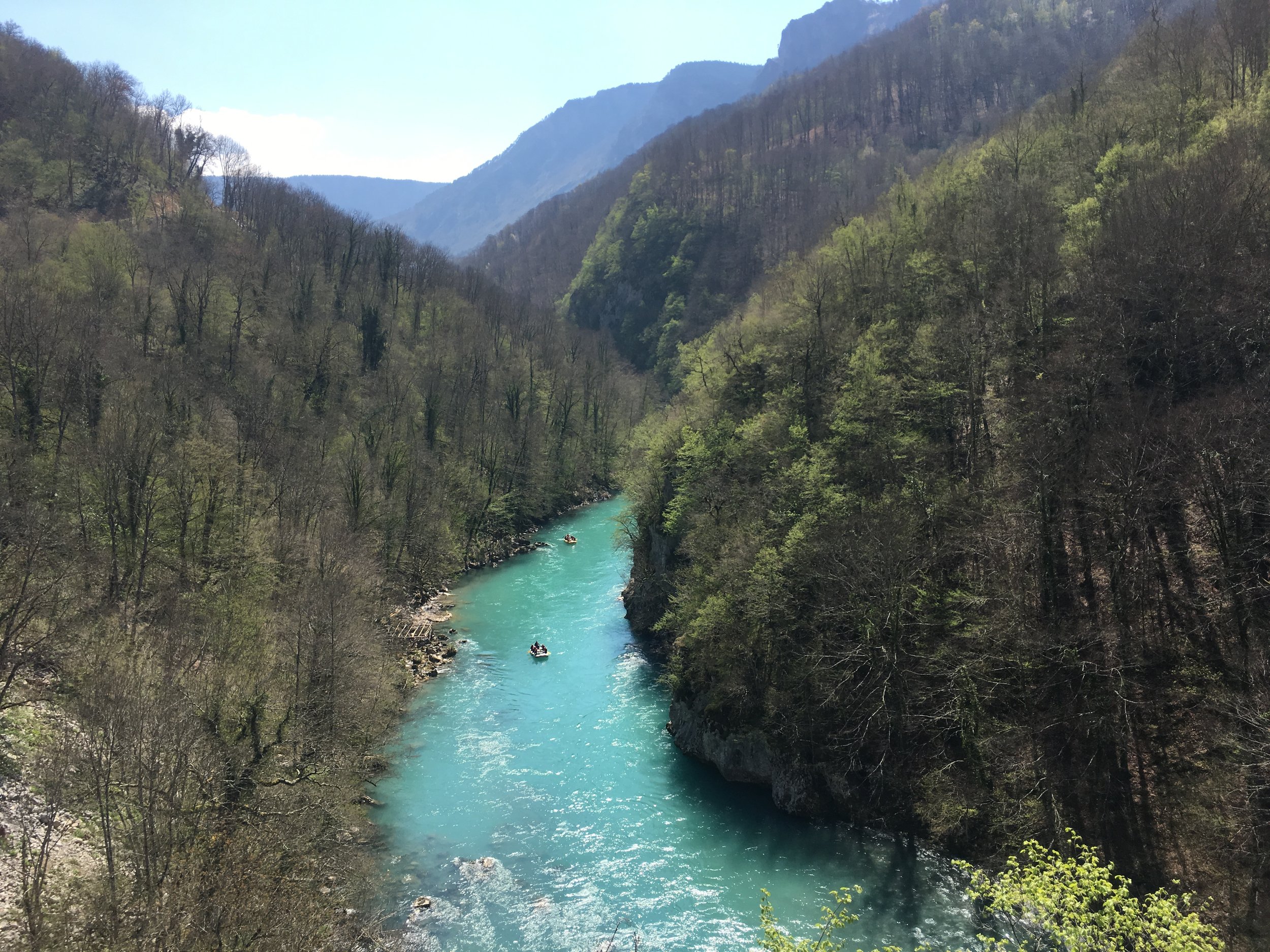FOČA
© Adnan Sose // Shutterstock.com
Foča is a beautiful city, the gateway to one of the most gorgeous parts of the country and arguably the best area for adrenaline adventures. High-octane stuff in stunning surroundings, in short. The city itself is relatively small and compact, with around 13,000 folks packed into the urban settlement on the banks of the Drina. People have always been busy in these parts, from its days as Hoča to its tumultuous daily life in the 21st century. It is a sad fact that when violence comes to Bosnia and Herzegovina, it seems to come with extra impetus here, and each war has been remembered for massacres and brutality. Today, Foča is 97% Serb, although you only need to go back 30 years for the demographic split to be 55% Serb and 39% Bosniak. Rewind the clock to the 1971 census, and Bosniaks were the majority. Those days are gone. Foča is an excellent base for exploring the surroundings, whether that is the mysterious sand pyramids of Daničići or the nearby Sutjeska National Park.
TRANSPORT
© John Bills
Foča bus station (Cara Dušana bb, +387 58 211 805) is large and ragtag. It operates on two levels, with the platforms below and the cafe, toilet, and ticket office above. There is a timetable on the platform that isn’t accurate, but plenty of buses come through these parts, with direct connections to Istočno, Banja Luka, Trebinje and more. The timetable on the monitor in the ticket office is as good as correct, for what it is worth. Buses to Podgorica also stop here. There are no shops or kiosks here, but you’ll find a couple just a short walk towards the town.
WHAT TO SEE AND DO
© John Bills
Church of St Sava
While it isn’t as monolithic as its namesake in Belgrade, Foča’s Church of St Sava is still pretty darn big. It is supposedly the third-biggest Serbian Orthodox Church, and it is a beaut. Constructed in 2006, the church is the centre of life in Foča today, with all the usual ceremonies occurring here throughout the year. It is a gorgeous piece of work, all intricate angles and extravagant stone, and its domes are visible from most vantage points in the city. Svetosavska
© John Bills
Aladža Mosque
Islam plays a vital role in the history of Foča, and the rebuilt Aladža Mosque is the focal point of all that magic. The original was considered one of the most beautiful mosques in the region, a stunning structure that travel tsar Evliya Çelebi was particularly fond of, constructed in 1549 under the watchful eye of master architect Ramadan-aga. It was referred to as the Colourful Mosque because of the intricate decorations that adorned its walls. The wall paintings were considered the best in the region. Of course, all of this is past tense, as the Republika Srpska army destroyed it in the war and even went so far as to hide the ruins to stop it from being rebuilt. Hatred never prevails, and the mosque was finally reconstructed in 2018. It is difficult to shake the feeling that it is hidden behind the tall trees of the park, but that only accentuates the beauty of its unveiling. The patterns on the walls are stunning, and the whole structure shimmers. A top five mosque in Bosnia and Herzegovina? If you’re asking me, I’ll put my thumb up. Osmana Đikića 3
© John Bills
Mehmed-Pasha Kukavica Clock Tower
Foča’s čaršija isn’t as big and bustling as it once was, but its historical attractions definitely merit attention from curious visitors. The Mehmed-Pasha Kukavica Clock Tower is arguably the highlight, although I will always say that about clock towers. Foča has an interesting historical relationship with clocks, sort of. This might be a bit of a reach, but it is said that the first clock to operate in Bosnia and Herzegovina was given to Dulejman-beg, a Herzegovinian border patrolman, as a gift from Dubrovnik. Dulejman-beg lived in Foča, so I’m putting two and two together to assume that the first working clock in Bosnia and Herzegovina was found in Foča. The clock tower was constructed sometime between 1758 and 1761, and it carries the grace that all clock towers seem to exude.
© John Bills
Museum of Old Herzegovina
The museum takes a Foča-centric approach to dissecting life in this delightful part of the world through a range of ethnographic exhibits and the life of Dr Risto Jeremić, the first domestic surgeon in Bosnia and Herzegovina and the first man from Foča to graduate university. The museum has many items and photos from history, putting Foča in its historical context in a fabulously engaging manner. The building was previously a hotel, adapted for education purposes in the 1950s. Kralja Petra I 11, +387 58 211 135
© John Bills
Sand Pyramids
I feel like the Sand Pyramids of Foča should be a much bigger deal. Located 9km outside of town on the road to Miljevina, these unique geomorphologic phenomena are very much living, growing all the time, encroaching on the world around them without a sinister bone to be found. Sand doesn’t have bones, but you get the point. The Pješčane Piramde are relatively well looked after, with staircases and viewing points for all your gawping requirements. There are seven sand pyramid locations, although only two are open to the public. Daničići
© John Bills
Oteša Waterfall
I fell arse over tea kettle trying to get down to this beauty, and then once again on my way back to the road, but I’d do it all again in a heartbeat. The Oteša waterfall is 12.5km outside of Foča (a little further on from the sand pyramids) and hidden from view; you’ll have to rely on your ears for this one. The waterfall is named after the Oteša River and is at its best in the spring when the snow has melted, and the weather is improving. Miljevina
© John Bills
Bey’s House
You can be forgiven for missing the Begova Kuća, as this splendid piece of 18th-century architecture is somewhat hidden behind a large gate featuring a mural of a goat. Yes, that is correct. The goat isn’t entirely random, of course, as the house is now the headquarters of Foča’s hunter’s association, and this grand old house is now a cafe. Not one of those modern cafes either; I’m talking an actual old man cafe, where the same group of chaps hang out and drink their drinks and have their conversations. The house is eternally tied to Idriz Beg Avdagić and his family, a wealthy group who built the residency following the architectural norms of the time. By all means, stop by here for a coffee or a beer and marvel at the beauty of it. And for what it’s worth, the goat mural is awesome. Šantićeva
© Maurizio Fabbroni // Shutterstock.com
Čaršija
The Clock Tower is the highlight, but what of the rest of Foča’s old centre? Little remains of its original aesthetic, unfortunately, as the violence of the 1990s was focused on leaving little trace, but magic is never truly extinguished. Foča’s Čaršija sits on a gentle slope in the town, and it doesn’t take an urban architect to see the benefits of this spot. Running water is nearby, the slopes are amenable to small trading posts, and the busy trade route does its business below. This was the Ottoman core of Foča, a place where more than 20 different trades and crafts flourished, from butchers to bookbinders and barbers to blacksmiths, with tanning and leatherwork the most lucrative. Foča at the headquarters of the Herzegovina sandžak, what Biznasty would call “kind of a big deal,” but those days are gone. A shell is all that remains of the Mehmed Pasha Kukavica mosque, although the rebuilding of the Careva Mosque gives hope that one day more will rise from the ashes. For now, the Čaršija is a memory breathing through empty facades.
© John Bills
Promenade
The whims of the Drina River make Foča a beautiful town for a stroll, and both sides of the water are set up for such endeavours. The simple delights of a paved path, right? I don’t need to do much lyrical waxing here because walking along a beautiful river should sell itself.
© John Bills
Prince Karl Iron Bridge
There isn’t a heap of concrete information about this bridge, which makes sense; it is built of iron, after all. Hah! Fantastic. I apologise. The Prince Karl Iron Bridge was constructed on the outskirts of town at the end of the 19th century, and it is inherently linked to the development of rail in this part of the country. The trains didn’t really come here, but it is the thought that counts. The bridge was completed in October 1884 (two years after work began), and it did its job until Tito ordered its tactical destruction in May 1942 (38 years to the day before he died, if you are into conspiracies). It was rebuilt following the war, bombed again in 1995, and renovated in 2018. Most 9. Maj
© John Bills
Rafting
Foča has developed a reputation as the adrenaline capital of Bosnia and Herzegovina, and for good reason. The waters get pretty wild in these parts, and the area surrounding town is packed with brilliant rafting camps offering everything from high-octane hurtling to the most leisurely activities of drinking and eating. New camps seem to pop up every summer as more and more folks venture here, searching for thrills and spills. I’ll list a few of the better camps in the accommodation section below.
BREWS, BOOZE AND BITES
© John Bills
Foča is a social town with many cafes and restaurants, so you shouldn’t have trouble finding somewhere to eat and drink. Mozart (Kralja Petra I, +387 58 212 888) tends to be the first place people recommend, be it for the first coffee or the last cocktail and all the meals in between. Zlatna Dunja (Njegoševa 1, +387 58 210 270) is an excellent restaurant serving traditional dishes (excellent gulaš), while Tresor (Njegoševa, +387 66 988 442) is a more than decent pizzeria. On the liquid side of the ledger, Kelt Pub (Njegoševa 10, +387 65 387 281), Vizantija (Cara Dušana) and Cinema Club (Krajiska bb, +387 65 960 833) are all top-notch. Hemingway was fabulous, but it seems to have closed. Further out of town, Danko brews excellent beer at Hotel Kompas (Patkovina, +387 66 770 304), Kriva Drina (Paunci, +387 62 215 850) is a super-friendly cafe and restaurant on the edge of the municipality, and Boletus (M20, +387 66 370 178) is a little shop selling gorgeous mushrooms picked from the surrounding forests.
SLEEPING
© John Bills
Hotel Zelengora (Njegoševa, +387 58 210 013) is now open for business, with comfortable rooms and lovely river views. Here’s hoping they get the cafe sorted out soon so breakfast and coffee can be added to the offer. That’s pretty much your lot in the heart of town (aside from a few private apartments), although those willing to head out a couple of kilometres will enjoy the serenity (and beer) of Hotel Kompas (Patkovina, +387 66 770 304). As mentioned, there are heaps of fantastic rafting camps around Foča, with Divlja Rijeka (M18, +387 65 229 819), Highlander (Bastasi, +387 65 475 201), Tara ’87 (Hum, +381 654 445 455) and Trio Lux (Čelikovo Polje, +387 65 588 726) among the best options.














